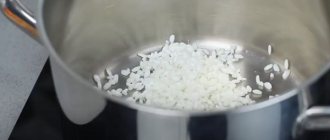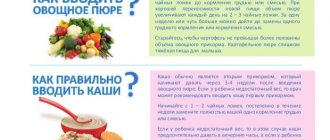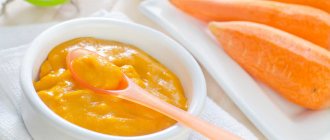As the baby grows older, formula or delicious mother's milk becomes insufficient for normal development and growth. The introduction of complementary foods to the infant's menu will help solve this problem. It’s worth starting your acquaintance with adult food with fruit and vegetable purees and cereals. Zucchini puree is often used for the first feeding for babies. This choice is determined by many factors - the hypoallergenicity of the product, the presence of beneficial microelements and the ease of its preparation. Read below on how to properly introduce zucchini into complementary foods, prepare puree and much more.
Useful properties of zucchini
It is wise to use zucchini puree for babies as the first food, because it has many beneficial properties:
- It is well tolerated by the child’s body, has a beneficial effect on the digestive system, helps avoid constipation, and does not cause bloating or colic.
- No allergic reaction. An allergy to zucchini occurs extremely rarely in infants.
- The vegetable is rich in microelements and vitamins, which are necessary for the normal development of infants. These elements include: magnesium, potassium, phosphorus, iron, vitamins C, B.
In addition to the benefits, the dish has other positive qualities:
- It is easy to prepare, recipes for making puree are accessible even to inexperienced mothers.
- The cost of fresh zucchini in summer is not high.
- It is possible to introduce the vegetable first into complementary foods and out of season, using frozen zucchini.
- Cooking time is minimal, which allows the young mother to save time.
Why is it better to start complementary feeding with zucchini?
There are several reasons for this:
- Does not cause allergies. The vegetable is considered hypoallergenic.
- Therapeutic effect. Zucchini puree has a good effect on digestion.
- Digested. It is completely absorbed in the baby’s body.
- Against constipation. Properly cooked zucchini stimulates appetite and forms normal feces without constipation.
This vegetable also contains the necessary vitamins and minerals for a 6-month-old baby: iron, sodium, potassium, magnesium, phosphorus, copper, vitamins C and group B.
When and how to start introducing complementary foods
Children's doctors advise introducing the first complementary foods at the age of 4 months to babies who are not gaining weight well or have problems with bowel movements. This often applies to children who are bottle-fed. If there is enough mother's milk, then introducing complementary foods should wait until the child reaches six months of age. The first feeding has its own characteristics. To do everything right, it is important to know the following.
Compliance with the dosage when introducing complementary foods: it is better to start with a small amount - the first time you need to give 0.5-2 teaspoons to see how the body reacts to the innovation. Gradually increase to 5-6 spoons at a time.
Introduction rules:
- the following methods for preparing puree : baking, boiling, steaming.
- Feeding time . The introduction of the first complementary foods should begin before 12 noon, preferably in the morning. This will provide an opportunity to observe the child’s body’s reaction to the new baby food. Problems that arise suddenly will not take you by surprise at night and will not spoil the sleep of your mother or child.
- The consistency of the dish should be similar to kefir or porridge; this will allow the child to eat the prepared puree without any problems.
- Storing vegetable purees : it is recommended to consume the dish within half an hour after preparation, while the beneficial properties of the zucchini are preserved. Heating is strictly prohibited.
- You should not force your child to try a new dish; it is also recommended to postpone the introduction of the first complementary foods if the child is capricious or unwell. The main thing is the right, good mood between mother and baby.
- , or butter (butter or vegetable) to the first feeding puree In addition, regardless of the method of introducing complementary foods, the puree should not include other ingredients - this will allow you to determine what the child has a negative reaction to.
- Postpone the introduction of zucchini to the menu if, after the first feeding, the child develops redness, pimples of unknown origin, or a negative reaction of the body occurs, it is worth postponing the introduction of zucchini to the menu and try another vegetable.
- Rules for selection and procurement
In order for vegetable puree to be as healthy as possible and safe for the child, it is necessary to correctly select the ingredients for it and process it. In the summer, there are no problems with buying zucchini - they can be found in abundance in markets and store shelves. If you want to get a completely natural product, not treated with chemicals, you need to grow it in your summer cottage. How to choose the right zucchini for the first complementary feeding and prepare the ingredient for cooking:
- To feed your baby, choose small, young zucchini.
- The vegetable should be elastic to the touch, without softness or spots, and the skin should ideally be light and smooth.
- It is important to ensure that the peel is free of damage, cracks, rot and other defects.
- If it is not possible to buy a young vegetable, then you need to peel the zucchini from the large seeds inside, using only the pulp in preparing vegetable puree.
- If you bought vegetables at the market or store, wash them thoroughly and soak them in cool water with added salt. This simple procedure will help get rid of nitrates.
- For one serving of puree you will need a small piece of vegetable. To prevent the zucchini from spoiling, it should be stored in the refrigerator, covering the cut area with cling film. During subsequent preparation, the edge covered with film should be cut off, and then cut the required amount for puree.
Recipes for pureed zucchini and other vegetables
- Zucchini and apple. Finely chop the vegetable and the apple, which has previously been peeled and seeded. Boil for 10 minutes, grind and give to the crumbs.
- Add broccoli. This puree is very healthy; the ingredients are prepared separately, since the broccoli takes a little longer to cook. After the vegetables are soft, they are crushed to a puree; no need to add spices.
- Recipe with potatoes. This dish is the most common among mothers; everyone is ready to make it. Every housewife has potatoes, and kids love them too. You need to cook the zucchini and potatoes in equal quantities and separately, since it takes more time to soften the potatoes. To make it cook faster, it is cut smaller than zucchini. The ingredients are then mixed and crushed.
How to freeze zucchini
You should avoid buying zucchini in stores in winter; artificially grown vegetables do not have such an abundance of microelements, vitamins, and sometimes they are saturated with harmful additives. Buying such a vegetable is unlikely to be beneficial for the baby. If the time of complementary feeding occurs in the winter, and there is no desire to introduce it with canned puree, store zucchini for the winter by freezing them. The undoubted advantage of such vegetables is that they do not lose their beneficial properties when frozen.
How to freeze zucchini for the winter for the first feeding
In summer, select the required number of beautiful, young zucchini. If possible, it is better to freeze vegetables grown in your own garden.
- Wash the zucchini thoroughly with water, cut off the tail and nose.
- Cut into cubes, rings or small slices.
- Place on paper towels to remove excess moisture.
- Pack into bags so that each contains as much product as needed for one preparation.
- Place in the freezer.
In winter, you can easily please your baby with fresh, tasty vegetable puree by taking out the required amount of vegetables from supplies.
Method for freezing zucchini for the first feeding
- Clean, washed zucchini is cut into small cubes.
- You need to pour water into the pan to completely cover the zucchini.
- Boil water and add chopped zucchini.
- Blanch for five minutes.
- Place in a colander to remove excess liquid.
- Pack into bags and place in the freezer.
How to steam puree for babies
They say that steamed foods retain much more vitamins. Well, for children this is exactly what is needed. Join us!
| INGREDIENTS | QUANTITY |
| zucchini | 1 PC. |
| Cooking time: 30 minutes | Calorie content per 100 grams: 24 calories |
How to cook:
- First of all, peel and rinse the vegetable.
- Next, cut it into small cubes of the same size.
- Fill the pan a quarter full with water.
- Place a sieve, colander or cheese basket on top.
- Place chopped zucchini inside.
- When it boils, cover the container with a lid.
- After about twenty minutes, remove the zucchini and immediately place them in a blender.
- Grind with an immersion blender until smooth.
- Cool a little and feed the baby.
Tip: if you have a double boiler, you can cook the puree directly in it.
How to prepare complementary foods from zucchini
Supermarkets offer a wide range of vegetable purees from different manufacturers. But many parents, in exceptional cases, purchase ready-made baby food and try to prepare everything themselves, carefully selecting ingredients, monitoring their shelf life, and cooking method. Young mothers are often interested in the question: how to prepare zucchini for the first feeding, which cooking method to choose?
Basic rules for preparing zucchini for complementary feeding
- The ingredients should be washed thoroughly, large seeds should be removed (if the zucchini is not young), and the peel should be peeled.
- The dishes where the zucchini will be cooked and served must be thoroughly washed and doused with boiling water.
- You should not overcook the vegetable; prolonged heat treatment can reduce the amount of beneficial microelements.
- Grind the finished product through a sieve to obtain a homogeneous mass. To make the work easier, you can use a blender or food processor, which will make a homogeneous mass in a matter of seconds.
- To make the puree smooth, liquid and easier for your baby to swallow, dilute the dish a little with the mixture or expressed mother’s milk. Cow's milk should not be used.
How to prepare delicious “puree” for the baby?
Zucchini cooks easily and quickly. This saves time for the mother and gives pleasure to the child. There are many recipes for preparing this dish for the first feeding, but only a few ways help to cook zucchini without depriving it of all its beneficial qualities.
To feed a child in winter, frozen zucchini is suitable, but lucky are those babies whose complementary feeding begins in the summer, when all the vegetables are fresh and as healthy as possible.
When choosing vegetables, pay attention to slightly underripe zucchini. They are juicy and considered the most delicious for kids. How many of them to take is up to you.
Cook in a saucepan
One way to cook zucchini is to cook it in a saucepan. This simple method requires a minimum of time and effort, and the result is a dish filled with vitamins and microelements that help the child grow and maintain good health. How to cook weaning zucchini in a saucepan:
- Pour clean water into a small saucepan and place it on the stove.
- Wash the zucchini thoroughly, peel it, cut off a small piece.
- Place the vegetable in boiling water and cook for a maximum of ten minutes until it becomes completely soft.
- Mash the zucchini with a fork, pass through a sieve or grind with a blender (the latter option is not very appropriate for the first feeding, since the amount of product will be too small for the technique).
- If the puree turns out to be too thick, you need to add mother’s milk or a little water in which the product was cooked.
- Cool the puree to room temperature, the dish is ready to eat.
How to cook
There are several general recommendations on which vegetable to choose and how to prepare it correctly:
- It is worth choosing young, strong, undamaged fruits.
- After washing and peeling the zucchini, a container of water in which the fruit is placed for a while will help get rid of nitrates. Then it is washed again. Seven-month-old babies do not need to remove the skin.
- Preference should be given to enamel dishes, and it is better to use a double boiler, it retains more vitamins.
- The prepared puree should not be very thick; the crumbs will better digest a thinner consistency.
- Starting from 6 months, other vegetables (zucchini, broccoli, cauliflower, carrots), as well as lean homogenized meat (chicken, turkey, rabbit) can be added to the zucchini.
- It is recommended to cook a new portion for each meal. This way, vitamins and microelements are preserved to the greatest extent and food poisoning can be avoided.
Zucchini has similar properties to zucchini, differing only in color, size, more delicate skin and small seeds.
Puree recipe
Let's look at several recipes for preparing zucchini for the first feeding, as well as as the newborn grows to one year. They do not require a lot of time and money.
At the very beginning, you cannot use various spices, even salt. You should only puree one vegetable in water.
Ingredients:
- White zucchini – 200 g;
- Drinking water – 150 ml.
Cooking sequence:
- Wash, peel, cut. The smaller the vegetable pieces, the faster the baby will be fed.
- Place the zucchini in boiling water, and after boiling, cook for another 8-10 minutes over medium heat.
- Using a blender or a fork will help you prepare the zucchini puree.
Complementary foods are introduced from half a teaspoon, then gradually increasing the volume.
You need to carefully monitor how the baby feels. If the intestines are not ready yet, then you can start with zucchini juice. And if the vegetable is not to your taste, the puree will taste better if you add a little breast milk to it.
- Soon you will need to create: A menu for a 1-year-old child.
After 7 months, you can mix in a spoonful of refined vegetable oil or butter.
With potatoes and carrots
If your baby has already tried one-component purees with various vegetables, why not mix them? This will improve the taste and add newness to familiar foods.
Ingredients:
- Small young zucchini – 0.5 pcs;
- Carrots – 0.5;
- Potato tubers – 2 pcs;
- Extra virgin olive oil – 1 tsp;
- Drinking water – 500 ml.
Cooking sequence:
- Wash the vegetables, peel them, and rinse again.
- Chop as finely as possible. The cooking time depends on this.
- First put the carrots into boiling water, after 5 minutes the potato tubers, after another 7 minutes the zucchini. Cook until done.
- We filter. Grind until smooth puree.
- Before serving, add oil.
With cottage cheese
If your child does not like vegetable complementary foods, you can try mixing it with soft cottage cheese. To do this, according to the first recipe for one-component puree, prepare zucchini and chop it. Then mix the resulting puree with the curd. The picky won't resist.
With meat
Children like meat more than vegetables because it has a more pronounced taste. Starting from 9 months, turkey or chicken are perfect.
Ingredients:
- Small zucchini – 1 piece;
- Poultry fillet – 100 g;
- Cold pressed olive oil – 1 tsp;
- Drinking water – 500 ml;
- A pinch of salt.
Preparation:
- Wash the meat and cut it into small pieces. Cook until the fibers split, adding a little salt.
- The zucchini can be cooked separately or added to the meat broth at the end of cooking. Simmer on fire for another 10 minutes.
- Grind everything into puree. If the consistency is thick, dilute with prepared broth or boiled water.
When preparing a dish with meat broth, you need to consider how the baby tolerates it. If he feels discomfort after eating, then cook and add only boiled water to the puree.
Zucchini soup
As complementary foods are introduced, the child's taste preferences change. A kid who happily ate puree from one zucchini eventually begins to wrinkle his nose.
Gradually, the child requires more nutritious and satisfying food. In this case, chicken soup with vegetables is perfect.
Ingredients:
- Chicken breast – 150 g;
- Zucchini – 150 gr;
- Broccoli – 150 gr;
- Onion – 1 piece;
- Carrots – 1 piece;
- Vegetable oil – 1 tsp.
Preparation:
- Wash, finely chop and boil the chicken until tender.
- Peel the onions and carrots, simmer them for 2-3 minutes, stirring constantly. Avoid frying.
- Cook broccoli and zucchini in salted water until tender.
- Combine all the products and grind with a blender to puree.
Steamed in a slow cooker
The most healthy products are obtained by steaming them. For infants, it is especially important to get the maximum benefit from food, so the best option is to cook zucchini in a double boiler or multicooker on the “Steam” mode. The steaming method is simple and provides the opportunity to prepare a tasty and healthy dish for your baby.
How to prepare mashed potatoes with your own hands for the first steamed feeding:
- Wash fresh zucchini well under cool running water. Peel it and cut into small cubes. Thaw frozen vegetables and drain excess liquid.
- Pour water into the bottom of the multicooker bowl and place the container for steaming.
- Place the ingredients on the grill, close the lid and turn on the multicooker to the “Steam” mode.
- Cooking will take from 7 to 13 minutes, it all depends on the power of the multicooker and the amount of food. Don't overcook the zucchini.
- Mash the finished product until a homogeneous puree is obtained.
Preparing puree for the winter
In autumn and winter, zucchini puree can be bought in a ready-made state in the store, but often such products can contain bacteria as a result of long storage and transportation. In order for your child to receive healthy food, it is recommended to independently prepare a valuable vegetable - zucchini - for the winter. It should be washed, cleaned, and the seeds removed from inside. Cut the vegetable into medium cubes, put in a bag and freeze.
To prevent the cubes from being compressed into one lump, the best option is to make the preparation in bags for one serving. Quickly frozen homemade vegetable cubes will not lose their beneficial properties. When you need to prepare puree for the first time, take them out of the freezer and steam them.
Portions
As a first complementary food, ½ teaspoon of one-component puree is enough. It is advisable to offer the product to the baby in the morning to monitor the body’s reaction. However, pediatricians say that there is no cause for concern, since an allergy to zucchini is a rare phenomenon. The portion increases daily until it reaches 100 g.
Basic cooking rules
Each mother must choose for herself which recipe to choose for her baby’s diet, but there are basic rules for use:
- Zucchini goes very poorly with milk, with the exception of breast milk. Therefore, it is better to leave the idea of mixing vegetables with regular milk for a later date.
- Zucchini makes friends with other vegetables, fruits, herbs, proteins and fats, but mixing the listed products at the first complementary feeding stage is not recommended.
- An allergy from zucchini is completely excluded, but discomfort in the intestines can be caused by its seeds, so any recipe recommends removing them. It is important not to be lazy and remove them before cooking - even in young vegetables.
- You can include zucchini juice in the menu for infants, offering your baby the drink half an hour before meals. The juice must be consumed within 10 minutes from the end of the extraction process. If you want to treat your baby to raw zucchini, first douse the vegetable with boiling water.
Take note of the video tutorial in which an experienced mother explains how to cook zucchini in a double boiler for a baby.
Benefit
For low birth weight babies and bottle-fed babies, complementary foods are introduced from 4 months - and here you can’t do without zucchini.
- Absence of allergies and negative reactions of the child’s body to vegetables.
- The delicate fiber of zucchini is remarkably digestible.
- If your baby has an allergy, zucchini will support the body during its treatment.
- The sodium and potassium contained in the product help strengthen the immune system and improve the supply of oxygen to the brain.
- The pulp contains vitamin C and essential minerals.
- Zucchini puree is a preventative against constipation, stimulates digestion and does not cause bloating.
- The vegetable normalizes water-salt balance and heart rate.
- Has a beneficial effect on nerve and muscle cells.
Zucchini is a “close relative” of pumpkin; it also has an Italian “brother” zucchini with a spicy taste, as well as squash, which differs in the shape of the flower. But it is the white-fruited variety of zucchini that needs to be cooked for babies. The cooking recipe should not include sugar or salt, otherwise it will be difficult to accustom the baby to healthy and healthy foods in the future.
Frozen zucchini for complementary feeding
- It is necessary to take only high-quality and young fruits.
- Wash the vegetable, remove the peel, cut off the end and beginning of the zucchini.
- Cut into circles, no thinner than three centimeters.
- Place the zucchini in a bag and put it in the freezer.
Thus, the zucchini retains its properties and can be easily prepared even in winter. Before cooking, do not first defrost the vegetable. Immediately throw into boiling water.
So we added something new to our children’s diet. I would like to believe that they will like the zucchini. When preparing complementary foods, follow the rules in the article. And if your baby refuses such a dish, don’t despair - everything will work out.
Healthy vegetable
When mother's milk is no longer enough for the baby, it is time to introduce complementary foods. It is believed that the first products that a child tries should be vegetables, namely vegetable puree. The best option for such an acquaintance is zucchini.
Per 100 grams of this vegetable there are 93 grams of water, 4.6 grams of carbohydrates, 1 gram of dietary fiber, 0.6 grams of protein, 0.3 grams of fat.
What are the beneficial properties of zucchini?
- The presence of B vitamins, provitamin A, ascorbic and nicotinic acid.
- High content of minerals and macro- and microelements. Among them: K, Mg, P, Ca, Na, Fe, S, Mo, Al, Zn. K:Na ratio -100:1 – maintains normal water-salt balance.
- Due to the fact that zucchini contains little fiber, but at the same time a large amount of water, the digestive system works without failures, and products are quickly absorbed.
- Zucchini protects the baby’s body from flatulence, colic and constipation.
- The threshold for developing allergies in infants is very low.
- The high content of pectin substances ensures good peristalsis.
- A diuretic effect is characteristic, although not very intense. But thanks to this, harmful substances can be eliminated from the body faster.
- Zucchini has a positive effect on the development of nerve and muscle tissue, and also maintains normal heart function.











